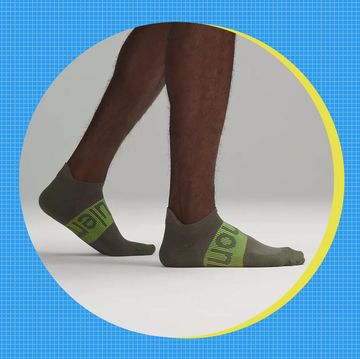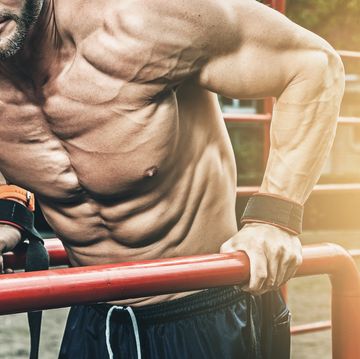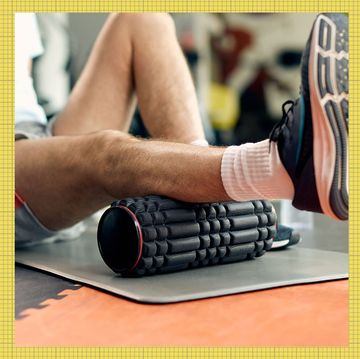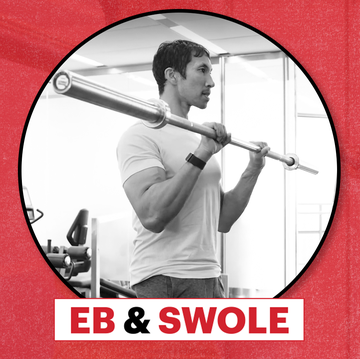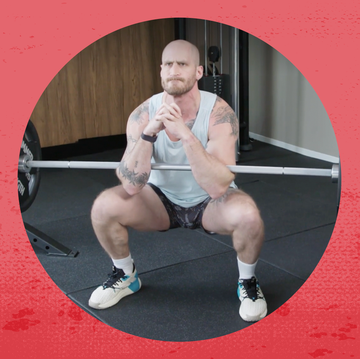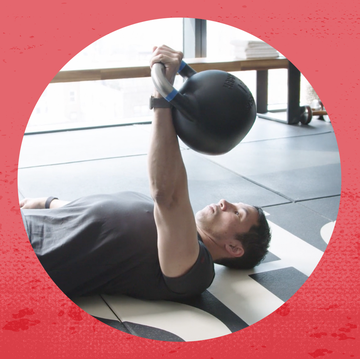Your body has about 650 muscles. It doesn't matter that you only care about four or five of them. You need every one in order to perform the normal functions of everyday life -- eating, breathing, walking, holding in your stomach at the beach.
Granted, you don't need to spend a lot of time thinking about most of your muscles. The 200 muscles involved in walking do the job whether you monitor them or not.
You could try to impress your friends at parties by telling them the gluteus maximus is the body's strongest muscle, or that the latissimus dorsi (in your middle back) is the largest, or that a middle-ear muscle called the stapedius is the smallest. But it probably won't work, unless you have some really unusual friends. And muscle trivia can't capture the wonder of muscles themselves -- the brilliance of coordinated muscles in motion, the magnificence of well-developed muscles in isolation.
We hope, in the following story, to help you understand a little more about how your muscles work, and thus how to make them bigger, stronger, and more aesthetically pleasing (if you're into that sort of thing). You can accomplish all three, if you know what's going on beneath the surface.
Muscle fibers, like children, have different abilities.
Your skeletal muscles -- the ones you check out in the mirror -- have two main types of fibers.
Type I fibers, also called slow-twitch, are used mainly for endurance activities. Type II, or fast-twitch, begin to work when a task utilizes more than 25 percent of your maximum strength. A movement doesn't have to be "slow" for the slow-twitch fibers to take over; it just has to be an action that doesn't require much of your fast-twitch strength. And an effort doesn't have to be "fast" to call your fast-twitch fibers into play.
A personal-record bench press is going to use every possible fast-twitch fiber (plus all the slow-twitchers, as we'll explain below), even though the bar probably isn't moving very fast.
Most people are thought to have a more or less equal mix of slow- and fast-twitch fibers. (Elite athletes are obvious exceptions--a gifted marathoner was probably born with more slow- than fast-twitch fibers, just as an Olympic-champion sprinter or NFL running back probably started life with more fast-twitch fibers.) However, the fast-twitch fibers are twice as big as the slow ones, with the potential to get even bigger. Slow-twitch fibers can get bigger, too, although not to the same extent.
So one strategy comes immediately to mind. . . .
To grow large, you must lift large.
When you begin a task, no matter if it's as simple as getting out of bed or as complex as swinging a golf club, your muscles operate on two basic principles of physiology:
1. The all-or-nothing principle states that either a muscle fiber gets into the action or it doesn't. (As Yoda said, long ago in a galaxy far away, "There is no try.") If it's in, it's all the way in. So when you get up to walk to the bathroom, incredibly enough, a small percentage of your muscle fibers are working as hard as they can to get you there. And, more important, all the other fibers are inactive.
2. The size principle requires that the smallest muscle fibers get into a task first. If the task--a biceps curl, for example--requires less than 25 percent of your biceps' strength, then the slow-twitch fibers will handle it by themselves. When the weight exceeds 25 percent of their strength, the type II, fast-twitch fibers jump in. The closer you get to the limits of your strength, the more fast-twitch fibers get involved.
Here's why this is important: One of the most pervasive myths in the muscle world is that merely exhausting a muscle will bring all its fibers into play. So, in theory, if you did a lot of repetitions with a light weight, eventually your biggest type II fibers would help out because the smaller fibers would be too tired to lift the weight.
But the size principle tells you that the biggest fibers are the Mafia hit men of your body. They don't help the underlings collect money from deadbeats. They suit up only when the work calls for their special talents, and when no one else can be trusted to do the job right.
In other words, a guy who's trying to build as much muscle as possible must eventually work with weights that require something close to an all-out effort. Otherwise, the highest-threshold fibers would never spring into action. Moreover, the smaller fibers don't need any special high-repetition program of their own, since the size principle also says that if the big fibers are pushed to the max, the small ones are getting blasted, too.
You can save your bones by building your muscles.
Many have tried to disparage the squat, framing it as an exercise that's brutal to back and knees. The charges never stick. Sure, the exercise can be tough on the knees, but no tougher than full-court basketball or other full-bore sports.
And for guys with healthy backs and knees, the squat is among the best exercises for strength, mass, sports performance, and even long-term health. The heavy loads build muscle size and strength, along with bone density, and thicker bones will serve you well when you finally break into that 401(k). So you won't be the guy who fractures his hip and ends up in a nursing home, although you'll probably pay some visits to your nonsquatting friends.
Setup: Set a bar in supports that are just below shoulder height and load the weight plates. (Be conservative with these weights if you've never squatted before. There's a learning curve.) Grab the bar with your hands just outside your shoulders, then step under the bar and rest it on your back. When you pull your shoulder blades together in back, the bar will have a nice shelf to rest on. Lift the bar off the supports and take a step back. Set your feet shoulder-width apart, bend your knees slightly, pull in your lower abs, squeeze your glutes, and set your head in line with your spine, keeping your eyes forward.
Descent: To begin the squat, bend your knees and hips simultaneously to lower your body. Squat as deeply as you can without allowing your trunk to move forward more than 45 degrees from vertical. Make sure your heels stay flat on the floor.
Ascent: Squeeze your glutes together and push them forward to start the ascent, which should mirror the descent. Keep your knees the same distance apart (don't let them move in or out). Your hips and shoulders need to move at the same angle--if your hips come up faster, you increase your trunk angle and risk straining your lower back. At the top, keep a slight bend in your knees.
Your quantity of muscle fibers is set at birth. The quality of those fibers is up to you.
On the day you were conceived, the gene gods had made three decisions that you might want to quibble with as an adult, if you could:
1. Your maximum number of muscle fibers
2. Your percentages of fast- and slow-twitch fibers
3. The shapes of your muscles when fully developed
On the downside, unless you were born to anchor the 4x100 relay at next summer's Olympics, you can forget about ever reaching that goal. The athletes at the extremes--the fastest and strongest, the ones with the best-looking muscles, and the ones capable of the greatest endurance--were already at the extremes from the moment sperm swam headlong into egg.
The upside is that there's a lot of wiggle room in between. Few of us ever approach our full genetic potential. You probably will never be a freak, but with the right kind and amount of work, you can always be a little freakier than you are now.
The best way to do that is to learn to use your muscles' very own juice machine.
If you want more muscle, you need more testosterone.
Everyone has some testosterone--babies, little girls playing with tea sets, grandparents shuffling through the laxative aisle at CVS--but no one has hormonal increases from one year to the next like a maturing male. His level increases tenfold during puberty, starting sometime between ages 9 and 15, and he hits near-peak production in his late teens. From there, his testosterone level climbs slowly until about age 30, at which point he hits or passes a few other peaks.
His muscle mass will top out between the ages of 18 and 25, unless he intervenes with some barbell therapy. Sexual desire peaks in his early 30s. Sports performance, even among elite athletes, peaks in the late 20s and starts to decline in the early 30s.
None of this is inevitable, of course. Unless you're that elite athlete who's trained for his sport since before the short hairs sprouted, you probably have the potential to grow bigger and stronger than you've ever been. And that could also put a little of that teenage explosiveness back into your sex life.
The testosterone/muscle-mass link is pretty clear in general terms: The more you have of one, the more you get of the other. Strength training, while it doesn't necessarily make your testosterone level go up permanently, certainly makes it get a little jiggy in the short term. We know of four ways to create a temporary surge in your most important hormone.
1. Do exercises that employ the most muscle mass, such as squats, deadlifts, pullups, and dips.
2. Use heavy weights, at least 85 percent of the maximum you can lift once on any given exercise.
3. Do a lot of work during your gym time--multiple exercises, multiple sets, multiple repetitions.
4. Keep rest periods fairly short--30 to 60 seconds. Of course, you can't do all these things in the same workout. For example, when you work a lot of muscle mass with heavy weights, you can't do a high volume of exercise, nor can you work effectively with short rest periods. This is among the many reasons you should periodize your workouts, which is a polysyllabic way of saying change your workouts every few weeks, rather than do the same thing from now till the gene gods recall the merchandise.
Growing muscles need more than protein.
The mythology surrounding protein and muscle building could fill a book, even though the science is fairly straightforward. Your muscles are made of protein (except the four-fifths that's water), so you have to eat protein to make them grow. You also have to eat protein to keep them from shrinking, which is why men trying to lose fat without sacrificing muscle do best when they build their diets around high-quality, muscle-friendly protein from lean meat, fish, eggs, poultry, and low-fat dairy products.
But if you're young, lean, and trying to gain solid weight, a lot of extra protein may not help as much as you think. Protein has qualities that help weight loss and may curtail weight gain. First, protein is metabolically expensive for your body to process. Your body burns about 20 percent of each protein calorie just digesting it. (It burns about 8 percent of carbohydrate and 2 percent of fat during digestion.)
Second, protein creates a high level of satiety, both during meals and between them. In other words, it makes you feel fuller faster and keeps you feeling full longer between meals. (This effect does wear off as you grow accustomed to a higher-protein diet, so it may not have an impact on long-term weight gain or weight loss.)
Finally, if you eat more protein than your body needs, it will learn to use the protein for energy. You want your body to burn carbohydrates and fat for energy, obviously, so a body that's relying on protein for energy is like a car that's using pieces of its engine for fuel.
The best weight-gain strategy is to focus on calories first, protein second. You should make sure you're eating at least 2 grams (g) of protein per kilogram (kg) of muscle mass. A kilogram is 2.2 pounds, so a 160-pound guy weighs about 73 kg and should take in a minimum of 146 g protein a day. But that's just 584 calories of protein, the amount you'd find in 15 ounces of chicken, two salmon fillets, or a 28-ounce steak. A protein-powder shake can amp up your totals, as well. If you need to eat more than 3,000 calories a day to gain weight, you'd better have some sweet potatoes with those steaks.
To build the muscle that counts when you need it most, do the deadlift.
Ever watched a Strongman competition on TV? They start with large men picking something even larger up off the ground. That's a deadlift--the most basic and practical of all strength-building movements. Now, have you ever watched a Strongman competition with your wife or girlfriend? She'll notice something you probably wouldn't: Not a single one of those guys has a flat ass. So pull up a barbell: You'll be able to perform everyday feats of strength--lifting a sleeping child or a dying TV--and you'll look a lot better when she follows you upstairs to the bedroom.
Setup: Load a barbell and roll it up to your shins. Stand with your feet shoulder-width apart. Position your shoulders over the bar as you grab it with an overhand grip, your hands just outside your knees. Keep your back in a straight line from head to pelvis. Finally, pull your shoulder blades together and down.
Just before the lift: Straighten your legs a bit to establish tension on the bar. Pull in your lower abs and squeeze your glutes.
First pull, from floor to knees: Straighten your legs while keeping your trunk and hips at or near the same angle. The bar should stay in contact with your skin at all times.
Second pull, from knees to midthighs: Stand up, driving your hips forward. Finish upright, with your shoulder blades back and down and your lower back flat.
Lowering: No need to perfectly reverse the motion; just slide the bar down your thighs and shins to the floor. Don't annoy your fellow lifters by dropping the bar.
Next repetition: Repeat the setup, letting go of the bar and regripping if necessary. You want perfect form on every repetition, and you won't get that if you bang out reps without stopping to set up properly before each lift. Remember, it's a deadlift. That means no momentum from one repetition to the next.
If you use perfect form, your lower back should give you no trouble. However, if you have preexisting back problems, your muscles may not fire properly for this exercise. Try the sumo deadlift instead. Set your feet wide apart, toes pointed slightly outward, and grip the bar overhand with your hands inside your knees. Your back will be more upright at the start, taking away some of the potential for strain.
If you want big triceps, drop the dumbbell and lift yourself.
Beginners almost invariably hit their triceps with light weights, limited ranges of motion, and simple, easy exercises. Which is fine . . . for beginners. For sizeaholics, the key to triceps development is lifting really, really heavy loads.
If you have time for just one triceps exercise, make it a dip. It's the big, basic movement that works all three parts of the muscle (thus the name "triceps"). And, because the bigger, stronger chest muscles are the prime movers--the ones that get your body moving from a dead-hang position--your triceps get to work against a much heavier load than they would in a triceps-isolating exercise.
How to dip: Hoist yourself up on parallel bars with your torso perpendicular to the floor; you'll maintain this posture throughout the exercise. (Leaning forward will shift emphasis to your chest and shoulders.) Bend your knees and cross your ankles. Slowly lower your body until your shoulder joints are below your elbows. (Most guys stop short of this position.) Push back up until your elbows are nearly straight but not locked.
Making progress: For most men, doing sets of dips with their own body weight is challenging enough. But when you reach a point at which you can do multiple sets of 10 dips, you want to add weight. The best way is to attach a weight plate or dumbbell to a rope or chain that's attached to a weight belt. Many gyms have belts specially designed for weighted dips and chinups. Another solution, especially if you work out at home, is to wear a backpack with weight plates inside it.
But the more weight you add, the more careful you have to be. Always lower yourself slowly--you don't ever want to pop down and up quickly on a weighted dip, unless you think you'll relish the feeling of your pectoral muscles detaching from your breastbone.
Precautions: Aside from the pec-tearing thing, you want to protect your shoulders. If you have preexisting shoulder problems, or feel pain there the first few times you try dips, you should skip them.
A comparable but more shoulder-friendly exercise is the decline close-grip bench press, using a barbell or dumbbells held together.
If size is your goal, avoid the Shrinking Man's Exercise.
Running doesn't build muscle mass. If it did, marathoners would have legs like defensive linemen, and workers in Boston would have to repave the streets each year following the city's signature race. But running shrinks muscle fibers to make them more metabolically efficient, thereby saving the pavement.
You'd think you could get around this by lifting weights in addition to running, but your body negates that work through a mysterious "interference effect." Your type II fibers--the biggest ones--will still grow if you run and lift. But your type I fibers won't, and even though they're smaller than the type IIs, they probably comprise 50 percent of the muscle fibers in your body that have any growth potential.
Cut back on your running program and you'll see growth in both your slow- and fast-twitch muscle fibers, and perhaps finally get your body to look the way you think it should. Excerpted from The Book of Muscle (Rodale, 2003).

